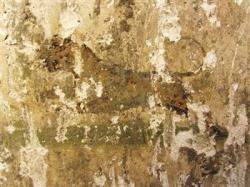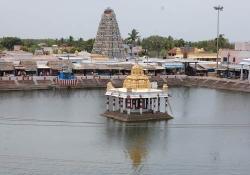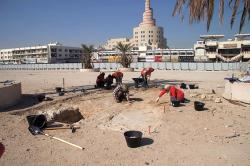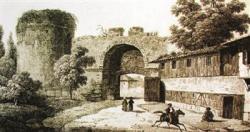INSTITUT SUPERIEUR D'ANTHROPOLOGIE
INSTITUTE OF ANTHROPOLOGY
ONLINE COURSES / COURS A DISTANCE
WINTER TERM : JANUARY 2014
REGISTER NOW
TURQUIE –  Tripolis - Researchers working at the ancient city of Tripolis in Denizli have discovered the figure of a leopard on the wall of a shop that was located next to the market area. “We know that the walls of the important buildings in the Roman era were covered with frescoes. We found one of the examples of it. There are various animal and plant figures on the walls of the shops. The leopard figure was significant to us. Zoologists from the university will conduct studies to find out the features of this figure,” said Pamukkale University Professor Bahadır Duman, the head of the excavation team at the ancient Aegean city. Two of the shops, which were built in the Roman era, have been revealed, said Duman, adding that the shops, which date back to the 3rd century A.D., opened onto the main street of the city. The excavation is currently working to unearth the entire ancient city, which is located in Denizli’s Buldan district.
Tripolis - Researchers working at the ancient city of Tripolis in Denizli have discovered the figure of a leopard on the wall of a shop that was located next to the market area. “We know that the walls of the important buildings in the Roman era were covered with frescoes. We found one of the examples of it. There are various animal and plant figures on the walls of the shops. The leopard figure was significant to us. Zoologists from the university will conduct studies to find out the features of this figure,” said Pamukkale University Professor Bahadır Duman, the head of the excavation team at the ancient Aegean city. Two of the shops, which were built in the Roman era, have been revealed, said Duman, adding that the shops, which date back to the 3rd century A.D., opened onto the main street of the city. The excavation is currently working to unearth the entire ancient city, which is located in Denizli’s Buldan district.
http://www.hurriyetdailynews.com/leopard-figure-on-ancient-city-walls.aspx?pageID=238&nID=59406&NewsCatID=375
INDE –  Tiruporur - On the first day of the excavation at the famous Kandaswamy temple on Rajiv Gandhi Salai (formerly known as Old Mamallapuram Road) in Thiruporur, on Tuesday, a team of archaeologists led by senior archaeological officer (A.O.) of the State archaeology department found only a dozen puja objects in the granite room on the temple premises. The archaeologists, led by K. Saraswathi, A.O. (Kancheepuram), unearthed puja objects made of brass and iron. Temple authorities found a small room on the northeastern end of the temple on December 2, when the workmen undertook cleaning operations on the premises as part of renovation of the Pallava-era temple. The room is around 12 feet long and six feet tall. At present, the archaeologists, along with temple authorities, have dug up to a depth of 10 feet but were unable to find any archaeologically-significant objects.
Tiruporur - On the first day of the excavation at the famous Kandaswamy temple on Rajiv Gandhi Salai (formerly known as Old Mamallapuram Road) in Thiruporur, on Tuesday, a team of archaeologists led by senior archaeological officer (A.O.) of the State archaeology department found only a dozen puja objects in the granite room on the temple premises. The archaeologists, led by K. Saraswathi, A.O. (Kancheepuram), unearthed puja objects made of brass and iron. Temple authorities found a small room on the northeastern end of the temple on December 2, when the workmen undertook cleaning operations on the premises as part of renovation of the Pallava-era temple. The room is around 12 feet long and six feet tall. At present, the archaeologists, along with temple authorities, have dug up to a depth of 10 feet but were unable to find any archaeologically-significant objects.
http://www.thehindu.com/news/cities/chennai/only-puja-objects-unearthed-at-tiruporur-temple/article5444956.ece
QATAR –  Doha - Archaeological investigations are under way in the heart of Doha to explore the origin and development of the city. A joint team of excavators from the University College of London (UCL Qatar) and Qatar Museums Authority (QMA) are examining open ground next to the Qubib Mosque adjacent to Souq Waqif. The site is under development as a future Q-Rail station, making the recovery of archaeological remains in the area extremely important. Initial investigations outside the Qubib Mosque have revealed buildings relating to the last phase of traditional housing in the area (around the mid-20th century), and older remains will be preserved below, UCL Qatar said yesterday. Excavations continue until mid-January. This will be the first extensive urban excavation in Qatar which aims at exploring the foundation of Doha, its growth and florescence as one of the major pearl fishing towns of the Gulf, and its transformation to a modern city.
Doha - Archaeological investigations are under way in the heart of Doha to explore the origin and development of the city. A joint team of excavators from the University College of London (UCL Qatar) and Qatar Museums Authority (QMA) are examining open ground next to the Qubib Mosque adjacent to Souq Waqif. The site is under development as a future Q-Rail station, making the recovery of archaeological remains in the area extremely important. Initial investigations outside the Qubib Mosque have revealed buildings relating to the last phase of traditional housing in the area (around the mid-20th century), and older remains will be preserved below, UCL Qatar said yesterday. Excavations continue until mid-January. This will be the first extensive urban excavation in Qatar which aims at exploring the foundation of Doha, its growth and florescence as one of the major pearl fishing towns of the Gulf, and its transformation to a modern city.
http://thepeninsulaqatar.com/index.php/news/qatar/263932/excavation-begins-to-explore-doha-s-past
KAZAKHSTAN – Almaty - Almaty could be 2,000 years old, 1,000 years older than previously thought. Karl Baipakov, director of the Margulan Institute of Archaeology, is advancing that theory on the basis of artefacts found near Navoi Street in Almaty. The excavated buried mounds date back to the first centuries of the modern era. Previously, archaeologists based their estimate of Almaty's age on 13th-century coins, the first items to bear the city's name.
http://centralasiaonline.com/en_GB/articles/caii/newsbriefs/2013/12/09/newsbrief-14
TURQUIE –  Edirne - Edirne Palace in the northwestern province of Edirne, which served the Ottoman Empire until the 19th century, is undergoing works to reveal its architectural value and heritage. Professor Nurhan Atasoy carried out a 56-year-long research project on Istanbul’s Topkapı Palace, which served as the administration center and official resident of the Ottoman Empire for 380 years. She said that Edirne Palace was the second most important palace after Topkapı, in terms of historical significance. Professor Mustafa Özer said that Edirne came under the rule of the Ottoman Empire in 1361 and a palace was constructed around the Selimiye Mosque. “When this first palace did not meet the needs, the Edirne Palace was constructed. We don’t have much information about the first palace. We only know that this palace was ruined during the construction of Selimiye Mosque’s social’s complex and included in the land of Selimiye,” he said. Özer said that the construction of the Edirne Palace had started at the time of Murat II and ended at the time of Fatih Sultan Mehmet. “The palace kept its importance all the time although Istanbul was the capital.” Özer said that the palace had two bridges named Kanuni and Fatih which were currently used by vehicles. Noting that they had found plenty of ceramics, tiles and balls during the excavations, Özer said, “We hope that these works will be long term in the Edirne Palace, which had been left to its fate for years. This palace is very important in terms of architecture and findings.”
Edirne - Edirne Palace in the northwestern province of Edirne, which served the Ottoman Empire until the 19th century, is undergoing works to reveal its architectural value and heritage. Professor Nurhan Atasoy carried out a 56-year-long research project on Istanbul’s Topkapı Palace, which served as the administration center and official resident of the Ottoman Empire for 380 years. She said that Edirne Palace was the second most important palace after Topkapı, in terms of historical significance. Professor Mustafa Özer said that Edirne came under the rule of the Ottoman Empire in 1361 and a palace was constructed around the Selimiye Mosque. “When this first palace did not meet the needs, the Edirne Palace was constructed. We don’t have much information about the first palace. We only know that this palace was ruined during the construction of Selimiye Mosque’s social’s complex and included in the land of Selimiye,” he said. Özer said that the construction of the Edirne Palace had started at the time of Murat II and ended at the time of Fatih Sultan Mehmet. “The palace kept its importance all the time although Istanbul was the capital.” Özer said that the palace had two bridges named Kanuni and Fatih which were currently used by vehicles. Noting that they had found plenty of ceramics, tiles and balls during the excavations, Özer said, “We hope that these works will be long term in the Edirne Palace, which had been left to its fate for years. This palace is very important in terms of architecture and findings.”
http://www.hurriyetdailynews.com/edirne-palace-being-revived-once-again.aspx?pageID=238&nID=59268&NewsCatID=375